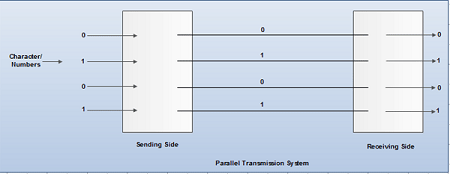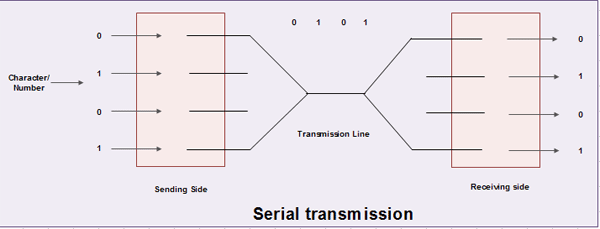Data transmission can be divided into parallel and serial data transmission.
We’ll be covering the following topics in this tutorial:
Parallel Transmission
One of more bytes of data is sent over two or more wires. Each wire transmits one digit of binary code. Therefore, sending one byte (8 bits) of data requires 8 wires as shown in Figure. In this type of transmission, it is necessary to detect where each byte of data is separated from the next. Normally, this detection is made on elapsed time base. The interface of a printer with PC is a good example for this case.
In parallel transfer, two major problems arise. The first is the wire itself. At least, nine wires (eight for the data bits, one for circuit ground) are needed. Still more wires are usually required to control the flow of data across the interface. Another problem lies in the very nature of the bits/voltages themselves. When a bit/voltage changes state from a one to zero, or vice versa, it does very rapidly in the order of nanoseconds (one billionth of a second). This abruptness is itself an essential part of the process of data Transfer Slow changes between zero and one are not even recognized as data. As a cable gets longer, its electrical properties (capacitance and inductance) restrict the abruptness with which a bit can change between zero and one, and data corruption or loss becomes likely. Because of this, the speed inherent in parallel data transfers makes transmission over long cables problematic.
 Therefore, its use is restricted to a few peripheral devices (such as printers) that are likely to be used in close proximity to the computer, or that must be operating at very high speeds.
Therefore, its use is restricted to a few peripheral devices (such as printers) that are likely to be used in close proximity to the computer, or that must be operating at very high speeds.
Serial Transmission
Data is sent over a single wire as shown in Figure Therefore, sending one byte does not require 8 wires. These .are sent one after the other. In this transmission, it is necessary to detect where each bit is separated from the next and also where each block is separated from the next. Normally, the former is detected based on elapsed time, the latter using one of a variety of so called synchronous system ‘that will follow next. For example, the RS-232C interface and Ethernet can be cited in this category. Serial transmission is suitable for long distance data transmission because it is less costly and more resistant to noise. Therefore, almost all transmission lines for data communication systems are serial transmission lines.
It takes at least eight times longer to transmit eight individual bits one after the other than to transmit them all simultaneously in parallel. This speed limit is insignificant for many typical applications. Serial peripheral devices are slow, at least in comparison to the internal speed of microprocessors. Each involves some time-consuming, sometimes mechanical process that greatly limits its speed: printers are limited by the speed of their print-heads, modems by the frequency restrictions of the telephone lines, and disk drives by their slow rotational speed. So, the speed inherent in the process of parallel data transfer is largely wasted on such peripheral devices. Hence, the serial method may afford to sacrifice some speed while still adequately servicing the peripheral devices. In such cases, the sacrifice in speed is in consequential in comparison to the increased reliability and transmission range.

 Dinesh Thakur holds an B.C.A, MCDBA, MCSD certifications. Dinesh authors the hugely popular
Dinesh Thakur holds an B.C.A, MCDBA, MCSD certifications. Dinesh authors the hugely popular